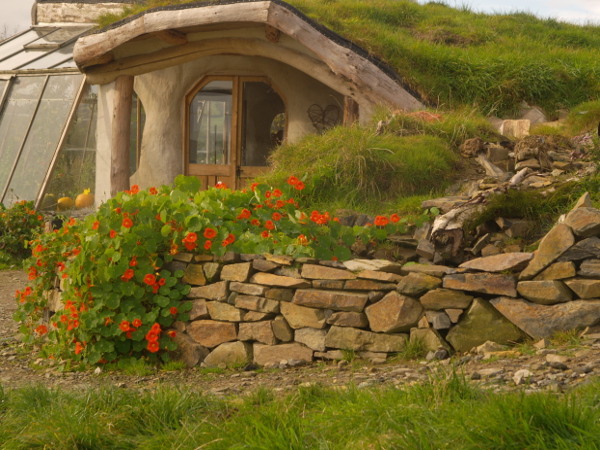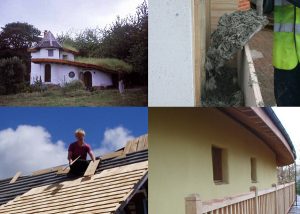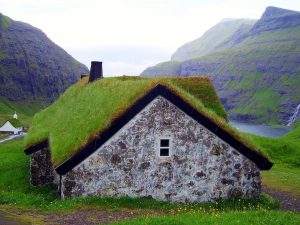Earth-sheltered houses - introduction

“Sunny, dry and pleasant, it offers huge fuel savings and a silent, green alternative to the asphalt society. ” – Malcolm Wells
Contents
What are earth-sheltered houses?
A building can be described as earth-sheltered when it has a thermally significant amount of soil or substrate in contact with its external envelope. What that dry definition means in practice is that earth-sheltered architecture includes buildings that have earth against their walls, on their roofs, or are entirely underground.
Earth-sheltering has a long history. Earth-sheltered houses at Keldur in Iceland are amongst the country’s oldest buildings, and houses of turf and earth have an ancient history in many regions of the world. A cursory search on the internet reveals the existence of ancient earth-sheltered dwellings in India, China, North Africa and Turkey; of course if we include in our definition caves, then earth-sheltering might be considered one of humanity’s oldest types of dwelling.

Earth-sheltered houses at Keldur in Iceland.
Technically speaking, there are three kinds of earth-sheltered building: earth bermed; in-hill or earth-covered; and underground or fully recessed.
The earth berm or bund consists of earth banked against the walls of a building. This might only be one wall, polar facing, or it could be all of the walls. Traditionally, stones would have been used in these berms as well, and/or turf; modern construction calls for insulation and waterproof membranes of course.
In-hill, or earth-covered construction takes the berm technique a step further and covers the roof of the building as well. Buildings like this are set into a slope or hillside and normally orientated towards the equator (or with the slope of the hill to take drainage into account – see Mike Oehler’s Basic Design, below).
Underground earth-sheltered buildings can also be called atrium-style because of the common use of an atrium or courtyard to ensure adequate light and ventilation. Some of the most famous subterranean houses are to be found in Coober Pedy, Australia, where underground living is a response to an extremely hot climate.
As well as these distinctions between different styles of earth-sheltered building, it is worth remembering that there are both relatively low-tech and high-tech approaches to this technique. There is a world of difference between concrete and steel earth-sheltered houses which whilst they can be extraordinarily energy efficient in use, have very high embodied energy and can cost £1000 per square metre, and hand-dug earth-sheltered constructions that use timber posts and shed-style roofs.

Building an earth-sheltered ‘hobbit house’ – from the top: preparing the ground; building the frame; finished house, interior; and exterior. Cost, around £3000. Source, Simon Dale.
What are the benefits of earth-sheltered houses?
Mike Oehler, author of The $50 and Up Underground House Book has an exhaustive list of advantages to be gained from his style of earth-sheltering:
- no foundation
- less building material
- less labour
- aesthetically pleasing
- lower tax
- warm in winter
- cool in summer
- better view
- built-in greenhouse
- ecologically sound
- increased yard space
- fallout shelter
- cuts atmospheric radiation
- defensible
- concealment
- closer to source of water
- relatively fireproof
- pipes never freeze
- superior flooring
- can be built by anyone
- weatherproof
- less maintenance
- soundproof
Above: a bit of inspiration for underground living (New Mexico).
More conventionally-minded architects and builders might not go as far as to list ‘defensible’ as an advantage of one of their designs, although to those of us with an appreciation of how the 21st Century might go on, it’s not necessarily the last thing on our minds.
On that note, earth-sheltering may just be the ideal architectural solution to an era of unpredictable climate change. High winds and extreme temperatures are both good reasons to consider earth-sheltering, and whilst you probably wouldn’t want to live in an earth-sheltered house on the flat in a time of flood, and a lot of earth-sheltered house designs struggle with drainage problems, Oehler’s basic design deals with the drainage problem by having a roof that goes with rather than against the slope of the land, and he makes it quite clear that building on the flat isn’t something he would necessarily recommend.
Most commonly listed advantages of earth-sheltered houses include thermal mass, so that these structures remain warm when the weather is cold, and cool when the weather is hot; energy efficiency, requiring less heating and little or no air conditioning; also, earth-sheltered buildings are often built for maximum solar gain, heating up naturally in the winter, but built so that the high summer sun doesn’t reach deep into the cool interior, whilst this isn’t necessarily a feature peculiar to earth-sheltered houses, it is one way in which their thermal mass can be used to great advantage. Privacy and soundproofing are also certainly benefits of living sheltered by the earth, as is ‘landscape fit’ – a sensitively built earth-sheltered house can disappear into the natural lie of the land.

Self-build earth-shelter – walls: drainage; berming granite walls; posts to support roof; building cob internal walls.
What can I do?
Earth-sheltering is certainly a technically challenging undertaking in some ways, but as with all building techniques, a great deal comes down to design choices.
It is quite possible to earth-shelter an existing building. Perhaps the most commonly seen approach these days is to put a green roof on a house, but in a similar fashion, walls can be bermed. We might imagine our own homes, or even whole towns and cities disappearing into a rolling landscape of earth-sheltering coming to look like meadows, providing bee forage, cooling and oxygenating.
In terms of self-building, earth-sheltering would seem to offer an ideal solution for those in search of good energy efficiency and landscape fit. The crucial question is whether ecological self-builders can manage to get their designs past a system of building regulation intended to fit an industry focused on creating lines of toxic boxes instead of homes for the future of people and planet.

Self-build earth-shelter – roof: board and insulation; waterproof membrane; trailer of turf; turfed roof; flue from stove through roof.
Of course all self-build or renovation projects are expensive, but at least some of the approaches to earth-sheltering can be done with modest resources, and the payback in energy savings should make the hard work involved well worthwhile.
Almost any kind of ground work or construction in the UK requires planning permission, but one interesting idea might be to dig a pond for the sake of wildlife, water storage and perhaps for aquaculture, and then to use the pile of earth generated to do a bit of earth-sheltering on whatever you’re living in. See what the planners say.
This will also inevitably involve coming up against building regulations, but as Jennifer Gray argues here, the main problem may very well be lack of official guidance. Pioneers will help shape the policy.
Hockerton Housing Project: earth-sheltered homes in Nottinghamshire.
Lots of different and inspiring examples of earth-sheltering do already exist: Phil and Helen Reddy’s house gives an idea of a high-specification build with costs at the time of around £1200 a square metre. The Hockerton Housing Project is a well-known example of earth-sheltered housing in a community setting, and its website offers all sorts of advice and inspiration both for new builders and retro-fitters. The HHP was built for £485 a square metre, completed in 1998.
Considered the father of the modern earth-sheltered movement, Malcom Wells (1926-2009) has left us an enormous body of work on which to base our earth-sheltered plans and projects. Pioneers like Wells imagined a whole new kind of architecture, a world in which the majority of buildings would one day be effectively underground. Of all the approaches though, the one that is perhaps the most accessible is that of Mike Oehler. He’s inspired many an ecological self-building pioneer, and instead of concrete and steel he advocates the use of PSP – posts, shoring and polyethylene sheeting; Oehler’s vision encompasses an affordable technique within everyone’s reach.

Brighton Earthship – open to the public. See Low Carbon Trust.
The very best of low-impact building makes good use of the resources available on-site; it minimises the energy consumption both in construction and in use of the building; it creates structures that are healthy and pleasant for people to live in; it does no harm to the wider landscape and preferably improves it, even offering new and enriched habitats for plants and animals. It also has to be remembered that climate change will challenge all of our buildings, and that the designs of what we build now must take into account a much altered world. Earth-sheltered architecture can address all of these questions, and in addition can be readily included in the list of empowering and accessible self-build techniques which can be learned and applied by most people whatever their previous experience in construction.
Having just read Mike Oehler’s book, I now want to go and start digging a hole; the thing to remember though is that good design goes before a good project.
Specialist(s)
Thanks to Mischa Hewitt of the Low Carbon Trust for information.
The specialist(s) below will respond to queries on this topic. Please comment in the box at the bottom of the page.

Simon Tilley, a chartered mechanical engineer, joined Hockerton Housing Project in 1995 after a background in manufacturing and sustainable development work. This included spending two years in Namibia working for Voluntary Services Overseas (VSO). His engineering skills have been put to good use in the project, designing and adapting the energy and water systems, as well as being a key player in the development of low-impact, affordable, earth-sheltered houses.




14 Comments
Hello !
My name is Alexis and my wife and I are launching a crowdfunding campaign in order to help us to build our own eco house in South France.
The structure would be made using the Hyperadobe technique. The building (50 m2) is gonna be as green as possible in terms of constrcuction.
Soil for the walls, pallet wood flooring and green roof on top of that !
We want to create a little self sufficient paradise by adding a biogas mini plant, solar panels or Wind turbine for energy management but also use as less as possible water by using dry toilet and Rainwater harvesting devices.
You can see more détails on our crowdfunding page :
https://www.justgiving.com/crowdfunding/ourearthbagecohouseproject
Best regards
Alexis
Hi, I’d really like to gain experience of building sheltered earth homes. Does anyone have any projects that they need help with? Or courses / training? Preferably in the UK although I’d consider travelling elsewhere. Thanks in advance!
Hi Lottie, if you’re UK based then the EBUKI website (www.ebuki.co) could be a useful starting point for you. They have their annual Clayfest event coming up soon, with lots of different methods represented, workshops and more.
British Earth Sheltering Association
Sadly BESA is no more but I have a collection of BESA newsletters from April 1990 to September 2001. Many are rather more than a newsletter and contain interesting articles and hinformation. If anyone is interested in these I would be pleased to provide further details.
Best regards
Graham Bond ( ex BESA member)
Sophie Paterson
Hi Sophie, I’d like to understand more about the viability of using earth block/rammed earth construction on a particular project I’m working on at the moment.
Not sure what your involvement is with EBUKI but I’m looking for a point of contact.
Thanks very much,
David Cooke
The Bespoke Oak Building Company Ltd
David Cooke – if you pop your comment on the rammed earth building page, I’ll get our specialist to answer if for you – it’s Rowland Keable of EBUKI, who answers queries on rammed earth building for us.
PS would you like a profile in our directory?
Dave Darby – thank you for the reply – sorry would you mind pointing me in the direction of the rammed earth building page please?
We’ve an earth sheltered project currently going through technical design and I’d like to explore alternative build methods.
Yes please send me details about the listing.
David Cooke
Found it thanks!
Hi – I wonder if Simon can contact me please? We have an earth sheltered project with approval to design/engineer and would like to discuss if possible.
Thanks very much,
David Cooke
The Bespoke Oak Building Co Ltd
Simon – that’s https://thebespokeoakbuildingcompany.com/
Cheers
Hello,
I am planning to build a low impact hobbit home in washington state. do you have any suggestions or references for architects that can help me design something natural? Also I have no clue what to expect budgeting wise? What does a typical 3 bedroom 2 1/2 bath single family hobbit home cost to build? I have my own on site timber to use, but I am new to this field and could just use a few pointers. Thanks!
Chris – that’s a bit vague. The article has suggestions and references, including budgeting. Let us know if you have specific questions.
It seems a bit disappointing to see a PIR rigid insulation on the roof of the second to last build, especially when the focus is on the insulative capacity of earth. Is there a reason for this? was it a building regulation requirements or that the roof didn’t have the structural capacity to support the volume of earth required to give sufficient insulation?
Do you have any more detailed information on the waterproofing and drainage techniques of retaining walls that also serve as a structural wall for the building. It would be good to see any examples that limit or omit the use of polymer membrane and cement.
thanks
rhawkins – those pics were from an informal / ‘unofficial’ build – you’d have to ask them about the materials they used, but I think they used what they had to hand.
We’ll ask Simon to respond to your other queries.
Thanks
Dave